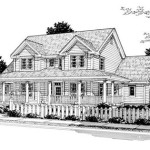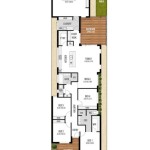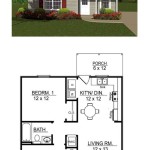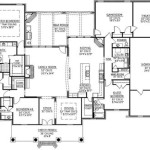Foundation Plan of a Residential House: A Comprehensive Guide
A foundation plan is a crucial component of any residential house construction project. It serves as the blueprint for the foundation of the house, which is responsible for transferring the weight of the entire structure to the ground. A well-designed foundation plan ensures the stability, durability, and safety of the house. ### Types of Foundation Plans There are various types of foundation plans based on the soil conditions, structural requirements, and design preferences: 1.Slab-on-Grade Foundation:
This type of foundation is typically used for homes built on stable soil conditions. It consists of a continuous concrete slab that rests directly on the compacted soil. It is cost-effective and easy to construct, making it a popular choice for residential housing. 2.Basement Foundation:
A basement foundation is ideal for houses built on sloping or unstable soil. It involves excavating a basement area below the ground level, providing additional space for storage, utilities, or living areas. Basement foundations are more expensive to construct compared to slab-on-grade foundations but offer better protection against water seepage and frost heave. 3.Crawlspace Foundation:
A crawlspace foundation is similar to a basement foundation but with a smaller excavation depth. It creates a crawlspace area between the ground and the house, allowing access to utilities and facilitating maintenance. Crawlspace foundations are commonly used in areas with moderate soil conditions and provide better ventilation than basement foundations. 4.Pier and Beam Foundation:
This type of foundation consists of concrete piers or pillars that support the house above the ground level. The piers are connected by beams, creating a framework that transfers the weight of the house to the ground. Pier and beam foundations are often used in areas with unstable or expansive soils, as they can accommodate soil movement without causing damage to the structure. ### Elements of a Foundation Plan A comprehensive foundation plan includes various elements that work together to create a solid base for the house: 1.Footings:
Footings are enlarged sections at the base of the foundation walls or columns that distribute the weight of the structure over a larger area. They are typically made of concrete and extend below the frost line to prevent frost heave. 2.Foundation Walls:
Foundation walls are vertical structures that extend from the footings to the ground level. They provide support to the upper structure and protect the house from moisture and pests. Foundation walls can be made of poured concrete, concrete blocks, or masonry. 3.Reinforcement:
Steel reinforcing bars are placed within the concrete footings and walls to provide additional strength and resistance to bending and cracking. The reinforcement helps distribute the loads evenly and ensures the structural integrity of the foundation. 4.Backfill:
After the foundation walls are constructed, the excavated soil is backfilled around the foundation to create a stable base and provide lateral support. Proper compaction of the backfill is essential to prevent settlement and damage to the foundation. 5.Waterproofing:
Foundation waterproofing measures are taken to prevent water seepage and moisture infiltration into the basement or crawlspace. This can include the application of waterproofing membranes, coatings, or sealants to the foundation walls and floors. ### Factors to Consider in Foundation Plan Design When designing a foundation plan for a residential house, several factors need to be carefully considered: 1.Soil Conditions:
The type of soil at the building site plays a crucial role in determining the appropriate foundation type. Soil bearing capacity, drainage characteristics, and susceptibility to movement should be carefully assessed. 2.Structural Requirements:
The weight and dimensions of the house, along with any additional structural elements such as porches or decks, influence the design of the foundation. The foundation must be able to withstand the loads imposed by the structure and distribute them evenly to the ground. 3.Climate Conditions:
The local climate, including temperature fluctuations, freeze-thaw cycles, and water table levels, can impact the foundation design. Adequate measures should be taken to address frost heave, water seepage, and other climate-related issues. 4.Building Codes and Regulations:
Local building codes and regulations establish specific requirements for foundation design and construction. These regulations ensure that the foundation meets safety and structural standards. ### Conclusion A foundation plan is a vital aspect of residential house construction, providing the base for the entire structure. The type of foundation and its design depend on various factors, including soil conditions, structural requirements, and climate conditions. Careful consideration of these factors and adherence to building codes and regulations are essential in creating a stable, durable, and safe foundation for the house.
Foundation Plan Of Residential House Design With Detail Dimension In Autocad Floor Plans How To

Foundation Plan Of 8x12m Residential House Is Given In This Autocad Drawing File Now Cadbull

Foundation Plan And Layout Details Of Single Story House Dwg File How To Open Plans

Foundation Plan Of 25x15m Ground Floor Residential Building Is Given In This Autocad Drawing Model Now Cadbull

Plan Of The Foundations Four Residential Houses Unified By One Base Scientific Diagram

Residential House Two Floor Distribution Plan And Foundation Drawing Details Dwg File Cadbull

Solved Draw The Foundation Plan Of Proposed Residential Chegg Com

Foundation Plan Of A Residential House Cadbull

Foundation Plan Of 8x12m Residential House Is Given In This Autocad Drawing File Thi Building Design

The Typical Foundation Plan Of 4 And 8 Story Buildings Scientific Diagram








